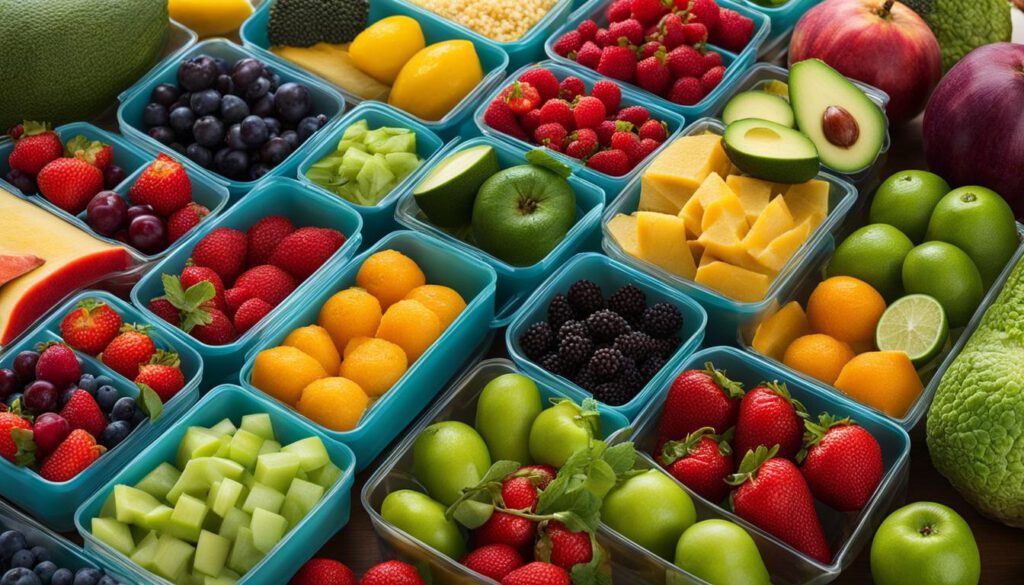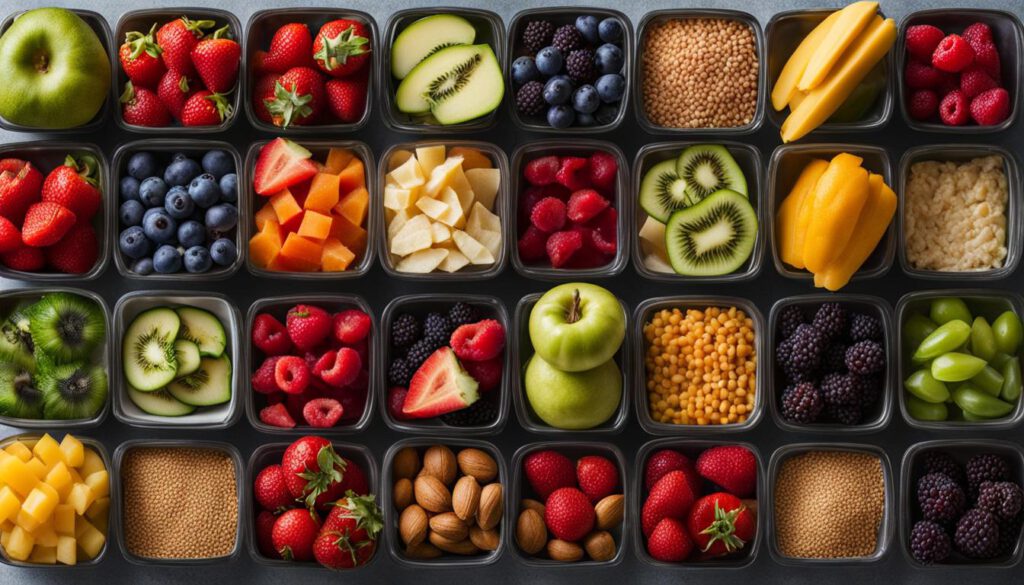If you’ve been on the hunt for fresh and fun kids’ lunch box ideas, you’ve found the perfect spot. I’ve spent years crafting, testing, and refining an abundance of delicious, nutritious, and kid-approved lunches for my picky eaters. Now, I’m here to share my favorite lunch box ideas with you, conveniently grouped by age range.
Key Takeaways:
- Engage your kids and involve them in the decision-making process to make lunchtime more enjoyable.
- Create a DIY assembly station where your kids can choose and assemble their own snacks or mini sandwiches.
- Encourage food art to make lunchtime fun and visually appealing for your children.
- Teach your kids about balancing their meals by incorporating a variety of foods from each food group in their lunch boxes.
- Plan ahead and make a menu plan to ensure you have everything you need for healthy and nutritious lunch box meals.
Engage Your Kids & Let Them Choose
When it comes to brainstorming lunch box ideas, involve your child in the decision-making process. Encourage them to choose fruits, vegetables, and snacks at the grocery store. By involving them, you’ll foster their independence and make lunchtime more enjoyable for everyone.
| Benefits of Letting Your Kids Choose: | Examples of Kid-Friendly Choices: |
|---|---|
|
|
By giving your child the opportunity to choose their lunch box items, you’re not only promoting healthy eating habits but also teaching them valuable decision-making skills. Empower them to make nutritious choices that they’ll be excited to eat.
DIY Assembly Station
Make lunchtime a creative and interactive experience with a designated lunch box assembly station in your kitchen. By allowing your kids to choose and assemble their own snacks or mini sandwiches, you’ll not only satisfy their taste buds but also empower them to make their own food choices. This hands-on approach will make lunchtime more enjoyable and encourage them to try new foods.
At the DIY assembly station, provide a variety of ingredients such as sliced veggies, cheese cubes, whole-grain crackers, and mini sandwich fillings like turkey, ham, or peanut butter. Place these ingredients in separate containers or small bowls, arranged neatly on a clean and organized countertop. Your kids can pick and choose their favorites, layering ingredients to their liking.
This activity fosters creativity and independence, as they can experiment with different flavors and combinations. It also gives them a sense of ownership over their lunch, making it more likely that they’ll eat and enjoy it.
Plus, the DIY assembly station is a time-saving hack for busy parents. Instead of spending hours preparing individual lunches, you can set up the station the night before, ensuring that everything is conveniently in one place for your kids to assemble their own lunch boxes in the morning.
Introduce your little ones to the joy of personalizing their meals by incorporating this DIY assembly station into your lunchtime routine.
Food Art Fun
Transform lunchtime into a fun eating adventure by encouraging your children to create food art. Let their creativity soar as they arrange fruits and veggies in fun shapes or create colorful patterns. You can also use cookie cutters to shape sandwiches into playful designs. Not only will this engage their imagination, but it will also make their lunch boxes visually appealing.
One creative idea is to make fruit skewers with a variety of vibrant fruits like strawberries, grapes, and pineapple chunks. Thread them onto colorful skewers for a colorful and nutritious treat. Your kids will be excited to find these delightful creations in their lunch box.
When it comes to food art, the possibilities are endless. Let your children experiment with different combinations of colors, shapes, and textures to make their meals more enjoyable. This is a great way to introduce them to nutritious foods while making lunchtime a fun experience.
Balancing Act
Use lunch box preparation as an opportunity to teach your kids the importance of building a balanced meal. Encourage them to include a variety of foods from each food group in their lunch boxes. By showing them that each food group brings its own nutritional value, they’ll learn to appreciate diverse flavors and enjoy a well-rounded meal.
Key Nutrients for a Balanced Lunch Box
When preparing your child’s lunch box, aim to incorporate the following key nutrients:
- Protein: Include lean protein sources such as grilled chicken, turkey slices, boiled eggs, or plant-based alternatives like tofu or hummus. Protein helps in growth and repair of body tissues.
- Whole Grains: Choose whole grain bread, wraps, or crackers to provide sustained energy and essential fiber for healthy digestion.
- Fruits and Vegetables: Include a variety of colorful fruits and vegetables to provide essential vitamins, minerals, and antioxidants.
- Dairy or Dairy Alternatives: Include a serving of dairy or calcium-rich alternatives like yogurt, cheese, or fortified plant-based milk to support bone health.
- Healthy Fats: Incorporate sources of healthy fats like nuts, seeds, or avocado, which help keep your child’s brain and body functioning optimally.
A Sample Balanced Lunch Box
Here’s an example of a balanced lunch box that includes foods from each food group:
| Food Group | Food Item |
|---|---|
| Protein | Sliced turkey breast |
| Whole Grains | Whole wheat wrap |
| Fruits and Vegetables | Grape tomatoes and baby carrot sticks |
| Dairy or Dairy Alternatives | String cheese |
| Healthy Fats | Trail mix with almonds and dried cranberries |
By offering a balanced lunch box, you’ll provide your child with the necessary nutrients for optimal growth and development. Their meals will be more satisfying and enjoyable, keeping them focused and energized throughout the school day.
Plan Ahead
When it comes to packing your child’s lunch box, a little planning goes a long way. Taking a few minutes each week to plan out the menu can save you time and ensure that you have all the necessary ingredients on hand. Not only will this help streamline your lunch box preparation, but it will also ensure that your child enjoys a nutritious and balanced meal.
Consider your child’s likes and dislikes when planning their lunch box menu. Aim for a variety of options that include protein, whole grains, fruits, and vegetables. This will provide them with the nutrients they need to stay focused throughout the day and support their overall health and well-being.
Creating a Menu Plan
A menu plan not only helps you stay organized but also allows you to be more intentional with your child’s nutrition. Here’s a simple process to create a menu plan:
- Start by brainstorming a list of healthy lunch box ideas that your child enjoys.
- Refer to the food groups and aim for a balanced meal that includes protein, whole grains, fruits, and vegetables.
- Plan meals that can be easily prepared or assembled in the morning.
- Consider incorporating leftovers from dinner into the lunch box menu.
Once you have your menu plan, create a corresponding grocery list. This will ensure that you have all the ingredients you need when it’s time to pack your child’s lunch box.
Incorporating a variety of healthy school lunch ideas into your menu plan will keep your child excited about their meals. It also provides an opportunity to introduce them to new flavors and foods, broadening their palate and encouraging healthy eating habits.
Batch Cooking
Save time and make your lunch preparation a breeze with batch cooking. By cooking a large batch of chicken or roast vegetables in advance, you can have ready-to-use ingredients for a variety of nutritious school lunch ideas and quick and easy lunchbox ideas throughout the week. This allows you to quickly assemble delicious meals without having to start from scratch every day.
Batch cooking not only saves you time but also ensures that you have healthy and balanced ingredients on hand. Whether you’re packing a sandwich or a salad, having pre-cooked chicken or roasted vegetables ready to go makes the process much simpler.
Benefits of Batch Cooking:
- Saves time by preparing ingredients in advance
- Ensures you have nutritious ingredients readily available
- Allows for quick assembly of lunchbox meals
- Reduces stress and decision-making during busy mornings
Here’s an example of how you can use batch-cooked ingredients for different lunchbox meals:
| Ingredient | Meal Idea |
|---|---|
| Batch-cooked chicken | Chicken and vegetable wraps |
| Roasted vegetables | Veggie and hummus wraps |
| Batch-cooked chicken | Chicken Caesar salad |
| Roasted vegetables | Roasted vegetable quinoa salad |
To make batch cooking even easier, consider investing in high-quality containers that are freezer-safe and have compartments to keep different ingredients separate.

With the power of batch cooking, you can streamline your lunchbox preparation and ensure that you always have nutritious ingredients on hand. By cooking a large batch of chicken or roast vegetables, you can quickly assemble a variety of delightful and balanced lunch options throughout the week.
Get Creative with Leftovers
Don’t let leftovers go to waste! Repurpose dinner leftovers into delicious lunch box meals. By thinking outside the box, you can transform last night’s dinner into a tasty and satisfying lunch for your child. Here are some ideas to inspire you:
- Grilled Chicken Wrap: Take leftover grilled chicken and wrap it in a whole wheat tortilla with lettuce, tomato, and a smear of mayo. It’s a portable and protein-packed option that your kids will love.
- Pasta Salad: If you have cooked pasta leftovers, turn them into a refreshing pasta salad. Toss the pasta with some diced vegetables like cucumbers, cherry tomatoes, and bell peppers. Add a simple dressing made from olive oil, lemon juice, and herbs for extra flavor.
- Quesadilla Delight: Use leftover cooked meat, such as roast beef or shredded chicken, and combine it with cheese in a whole wheat tortilla. Heat it up in a skillet until the cheese is melted and the tortilla is crispy. Cut it into bite-sized pieces for your child to enjoy.
These ideas are not only easy to prepare but also ensure that no food goes to waste. By repurposing leftovers, you can create delicious and balanced lunch box recipes that your kids will look forward to.
Invest in Quality Containers
When it comes to packing your kids’ lunch boxes, investing in high-quality containers can make a big difference. Opt for compartmentalized lunch containers, like bento-style boxes, that allow you to pack different food items in separate compartments. This not only keeps the food fresh and appealing but also makes it easier for your child to access and enjoy their meal.
Leak-proof containers are also a great investment, as they prevent any spills or messes in your child’s lunch bag. Look for containers that are dishwasher-safe, which will save you time and effort when it comes to cleaning up after lunch.
| Benefits of Quality Lunch Containers | Features |
|---|---|
| Keeps food fresh: | Compartmentalized containers allow you to separate different food items, preventing them from mixing and keeping them fresh for longer. |
| Easier organization: | Containers with separate compartments make it easy to pack a well-balanced meal with a variety of food groups. |
| Convenient cleaning: | Dishwasher-safe containers can be easily cleaned, saving you time and effort in the kitchen. |
| Leak-proof: | Leak-proof containers prevent any spills or messes in your child’s lunch bag, keeping everything neat and tidy. |
By investing in quality lunch containers, you’ll not only ensure that your kids’ meals stay fresh and delicious but also make the lunch packing process more efficient and enjoyable.

Conclusion
Packing healthy and delicious lunches for your kids doesn’t have to be a daunting task. By involving your children in the decision-making process, providing a variety of options, and using creative presentation ideas, you can make lunchtime enjoyable and nutritious.
With these 10 healthy kids’ lunch box recipes, you’ll ensure your children have nutritious and delicious meals every day. From colorful fruit skewers to tasty wraps and balanced meal options, these recipes are easy to make and packed with essential nutrients.
Remember to engage your kids and let them choose their favorite ingredients, as this will foster their independence and make lunchtime more enjoyable. Creating a DIY assembly station and encouraging food art fun will result in interactive and visually appealing meals.
To make the lunch preparation process even easier, plan ahead and take advantage of batch cooking and repurposing leftovers. Invest in quality containers for convenient and leak-proof storage of different food items.
With these strategies and 10 healthy lunch box recipes, you’ll create meals that not only nourish and fuel your children but also excite their taste buds. Make lunchtime a moment of joy and health with these easy and nutritious lunch box ideas for kids.
FAQ
Why is it important to involve my child in choosing lunch box ingredients?
Involving your child in the decision-making process fosters their independence and makes lunchtime more enjoyable for everyone. It also encourages them to choose healthier options and teaches them about balanced meals.
How can I make lunchtime more interactive for my kids?
Set up a designated lunch box assembly station in your kitchen where your kids can choose and assemble their own snacks or mini sandwiches. This hands-on approach allows them to be involved in their lunch preparation and makes lunchtime more interactive and enjoyable for them.
How can I make my child’s lunch box more visually appealing?
You can encourage your children to create food art by arranging fruits and veggies in fun shapes or patterns, using cookie cutters to shape sandwiches, or creating colorful fruit skewers. This will ignite their imagination and make their lunch boxes more visually appealing.
How can I ensure a balanced meal in my child’s lunch box?
Encourage your child to include a variety of foods from each food group to build a balanced meal. Show them the importance of each food group’s nutritional value, and aim for a balance of protein, whole grains, fruits, and vegetables.
How can I save time in preparing my child’s lunch box?
Take a few minutes each week to plan your child’s lunch box menu. Consider their likes and dislikes and aim for a balance of nutrients. Making a menu plan and a corresponding grocery list will ensure you have everything you need on hand, saving you time and effort.
How can I utilize leftovers for my child’s lunch box?
Repurpose dinner leftovers into delicious lunch box meals. For example, you can turn grilled chicken into a tasty wrap or transform cooked pasta into a refreshing pasta salad. This not only saves time but also reduces food waste.
What type of lunch containers should I invest in?
Invest in high-quality, compartmentalized lunch containers, such as Bento-style containers. These containers allow you to pack different food items in separate compartments, keeping them fresh and appealing. Choose leak-proof and dishwasher-safe containers for added convenience.
How can I make packing healthy lunches less daunting?
By involving your children in the decision-making process, providing a variety of options, and using creative presentation ideas, you can make lunchtime enjoyable and nutritious. These 10 healthy kids’ lunch box recipes will ensure your children have nutritious and delicious meals every day.

